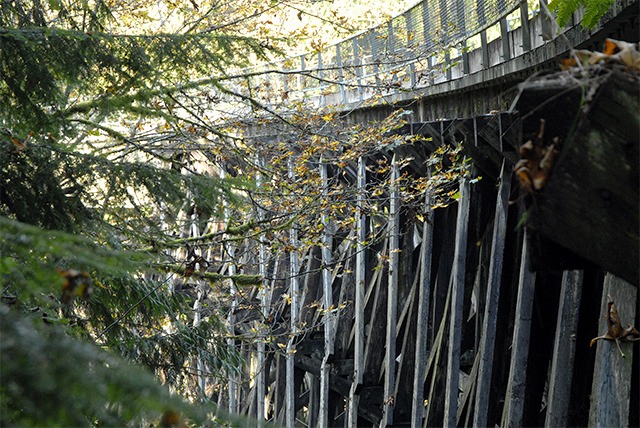Everyone stops on the Tokul Creek bridge.
It’s not that they need to; the Snoqualmie Valley Trail rises very gently up the Valley, and the bridge is about a mile along it from Tokul Road. Whether they’re on two wheels or two feet, though, the people who explore the trail as far as the 100-year-old Milwaukee Railroad trestle bridge seem compelled to pause there, and take in the view.
At nearly 100 feet high, the bridge offers a sweeping look across the Valley, and dizzying glimpses of the namesake creek flowing underneath. It’s also an impressive sight itself, stretching 400 feet over the plunging terrain of the creek canyon, and the 180-degree turn of the trail.
The Tokul Creek Trestle is, according to a King County Parks report on its historical significance, “the highest and one of the longest and largest of the trestles on the former Everett branch of the (Milwaukee) Railroad, and the only one that is fit into a tightly curving contour in a steep drainage.”
It’s a jewel, and for plenty of reasons, says Snoqualmie historian Dave Battey.
Tokul Creek is one of few remaining natural creeks in the county, since the land wasn’t logged all the way down to the waterway. The bridge over it is a rare survivor of the railroad era in the Valley.
Built in 1911 by the Chicago, Milwaukee and St. Paul Railroad, Milwaukee for short, the enormous bridge served freight trains for six decades, and daily passenger trains from 1913 to 1930. It was rehabilitated in 1949 with all new timber stringers supporting the bridge deck, abandoned in 1973 (the Milwaukee filed for bankruptcy in 1977), and converted to today’s concrete-deck surface in 1989. Long before then, though, many other railroad bridges had been demolished, primarily for safety reasons.
“Puget Power did that…” Battey said, “so people wouldn’t try to walk the rails.”
He remembers one of his first train rides, not on the Milwaukee line but on competitor Northern Pacific’s.
“It was the Casey Jones Special,” he said, “…and soon after, some of those incredible trestles between Fall City and the falls, were blasted.”
The Tokul Creek Trestle was safely off the power company’s land, and so preserved. Now it’s part of the county’s protected 31.5 mile trail from Rattlesnake Lake to Duvall, and a favorite stop for hikers and bikers.
Fall City historian Jack Kelley wrote in an article for the Fall City Historical Society that construction of the spur from Moncton to Everett, including the Tokul Creek Trestle, began in 1910.
“The track-laying crew arrived on the hill to the north of Fall City in 1911, and during the following year they reached Everett. Freight and mail services were extended to Fall City and a road past Ruther-ford Slough wound up the hill to the Fall City siding.
“The siding was gone by the late 1930s and the trains no longer stopped in Fall City.”
Besides being a survivor, the bridge also distinguishes itself structurally. It’s supported on timber sills instead of driven piles, “unlike many of the smaller trestles on the route,” according to the King County report.
A 75-foot steel girder supports the center of the span, with 16- and 15-foot trestles arrayed on either side of it.
Battey never rode a train across the Tokul Creek Trestle, but many people, both local and distant, did.
The line extended to Everett, so, “if you had relatives in Everett, you’d look up the dollars and cents — and the fun, because railroads were fun to ride — and you’d go visit your relatives in Everett.”

Take a look under the bridge and you’ll see more rare features, including its construction with heavy timber “bents” and sill construction instead of driven piles.


Construction of the Tokul Creek Trestle for the Milwaukee Railroad spur from Moncton to Everett was complete in 1911, when this photo was taken.


On the way to the bridge from Tokul Road, you’ll pass this giant culvert. It replaced “the killer bridge” years ago, after the wife and children of a local game warden were killed after sliding off the bridge in icy weather.


One of the trestle-built bridge’s distinguishing features is its curved construction, 400 feet across the Tokul Creek canyon.


